2023 Guide to Interpreting NBME Practice Exams for Step 1 and Step 2

7212 Views
Almost all students preparing for the USMLE Step 1 or Step 2 will take at least one (hopefully more!) practice test leading up to test day. While various practice tests are available to assess your performance, many students will turn directly to the NBME practice tests. In this post, we will cover everything you need to know about using NBME practice exams for your USMLE prep! How accurate are the NBME practice exams at predicting your Step 1 and 2 CK performance? Which NBME is the best predictor for your Step 2 score, or how ready you are to pass Step 1? What do you need to do to interpret your score report? How can you utilize the information you get from your score report to inform how you study? And some extra tips to set you on the road to success!
For those who are unaware, the USMLE (United States Medical Licensing Examination) is owned by two organizations: the Federation of State Medical Boards (FSMB) and the National Board of Medical Examiners (NBME). The NBME practice tests are directly from the organization that will administer the test. Naturally, these tests have extremely high utility in preparing for your real test and providing you feedback on your performance. While many students are primarily interested in knowing their predicted scores on these practice tests, there is a lot more information in the score reports you will receive after taking a test that can aid you in your preparation. We have created this guide to help you understand the score reports and how to interpret them.
Interpreting Your USMLE Step 1 NBME Score Report
The practice tests from the NBME for USMLE Step 1 are also known as the Comprehensive Basic Science Self-Assessment (CBSSA). These tests consist of 200 multiple-choice questions (four blocks of 50 questions). You can take these in a standard-paced (timed under timing conditions that are comparable to a real USMLE exam) or self-paced mode (this option offers four times as long to complete each section). After taking your examination, you will receive a score report. You can find an example of this score report here. Now that the USMLE Step 1 is a strictly pass/fail examination, these practice tests will not give you a score. Rather, they will provide you with a Total Equated Percent Correct Score (TEPCS) and a probability of passing Step 1 within a week. Here is an example of how this will look:
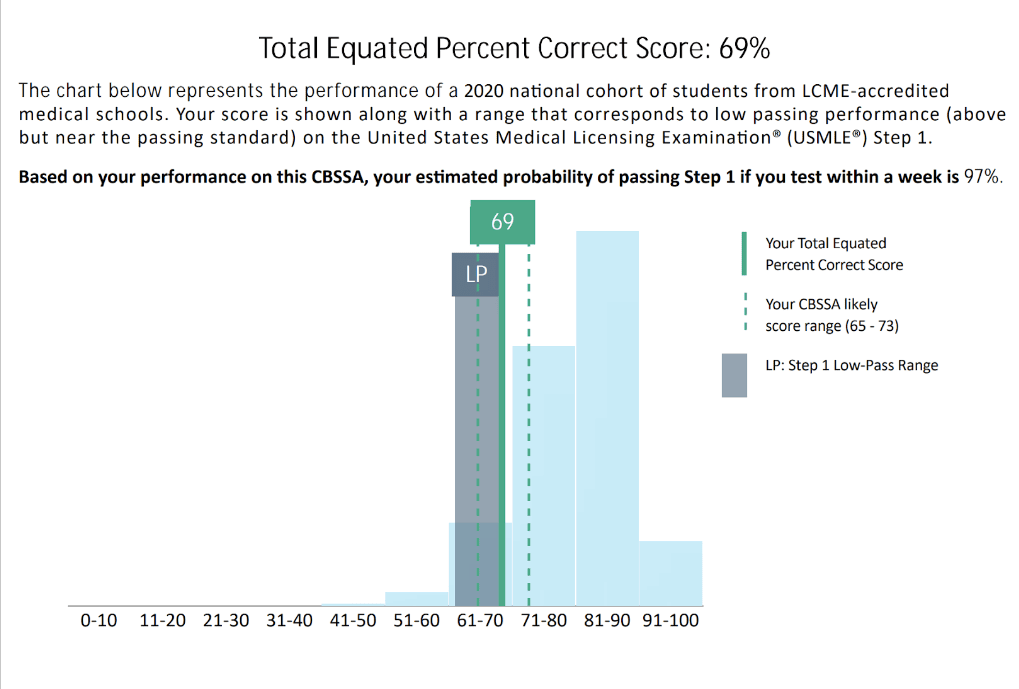
In this example, we can see that the student received a TEPCS of 69%, and has a 97% likelihood of passing Step 1 within a week. According to the NBME, the TEPCS is technically a “percentage of the content that you have mastered…[which is] statistically adjusted to account for slight variations in exam form difficulty and may be slightly lower or higher than that actual percentage of questions you answered correctly on this specific form”. In short terms, you can think of the TEPCS as a curved percentage correct. Importantly, the NBME reports that “if you tested again without learning or forgetting…, your score would fall within 4 points of the reported score two-thirds of the time.” That makes the NBME an excellent and accurate predictor of your Step 1 performance.
Determining if You Are Ready to Take Step 1 Based on Your NBME Score
In the figure above, you can also see a low pass range. The USMLE reports that this range represents “performance that is above but near the passing standard”. In other words, a performance that is sufficient to pass Step 1, but only by a small margin. The USMLE cautions that any overlap with the low pass range and your TEPCS should warrant “extra caution.”
The NBME also reports that there are a “few things to keep in mind”:
- A 90% probability of passing Step 1 still means there is a 10% likelihood of failing
- A 90% probability of passing Step 1 does NOT mean you have mastered 90% of the content (the TEPCS represents what percentage of the content you have mastered)
- The probability of you passing Step 1 is only valid if the test is taken within a week of receiving this score
- Your probability of passing Step 1 is an estimate and not a guarantee
There are a few scenarios that the NBME reports on how to interpret your score, which we have shared below:
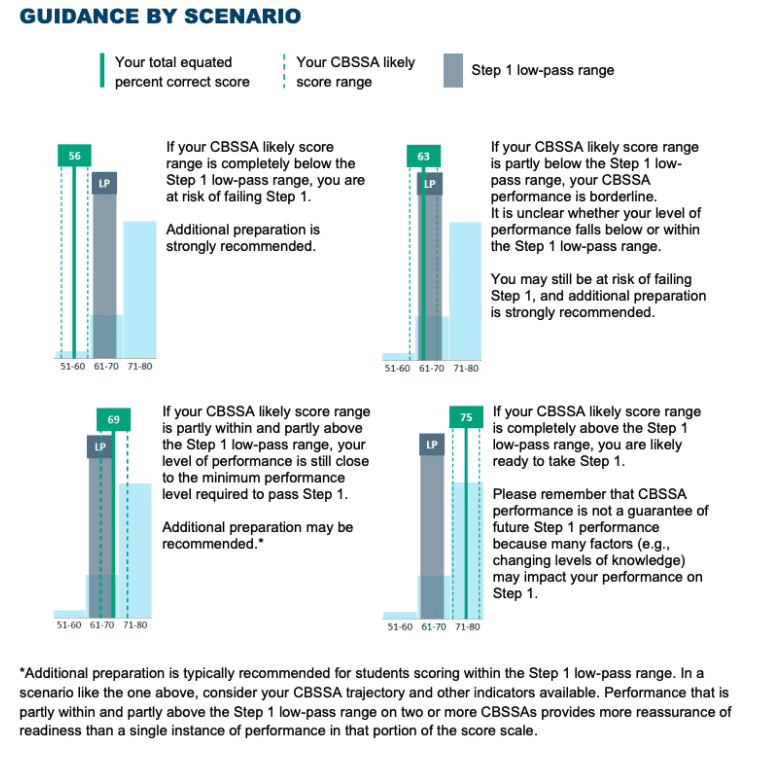
Using Your NBME Score Report to Inform How You Study for Step 1
Next, you will see a breakdown of your performance by Physician Task, System, and Discipline. Shown below is an example of these data grouped by System:
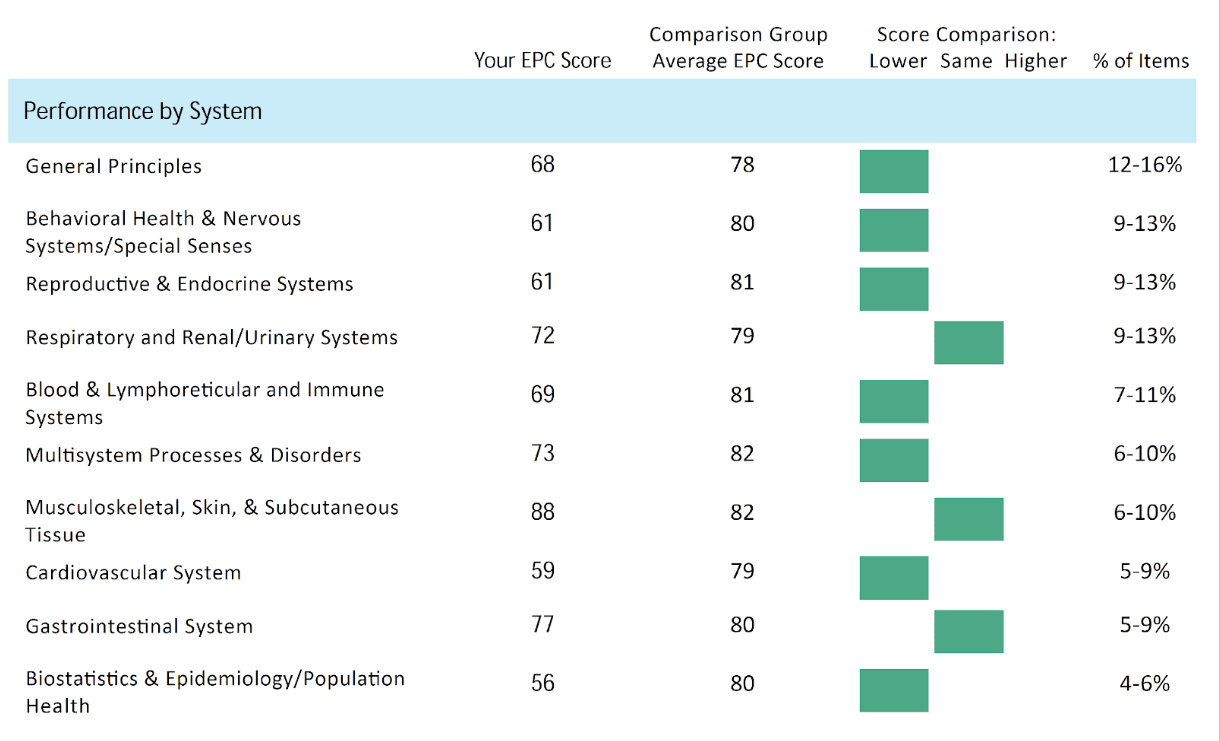
The NBME will give you an accurate report of your performance on the separate material contained within the USMLE Step 1. This data should be used to inform what you focus on moving forward! As you can see in this table, there are the listed systems, your equated percent correct (EPC) score for this individual system (calculated similarly to the TEPCS), Comparison Group Average EPC Score (the score of Step 1 first-takers on CBSSA), Score Comparison (how you perform relative to your peers), and % of items (what percentage of this system makes up of the entire test).
When interpreting these data, you should aim for all your score comparisons in the “Same” or “Higher” category. The absolute EPC score can fluctuate from test to test. You can use the Score Comparison to estimate how you perform on that Physician Task, System, or Discipline. This data should help guide your studying so you can focus on specific subjects where you underperform.
When determining which subjects to focus on, you should consider the following:
- How far your EPC is below the Comparison Group Average EPC.
- What % of the test is comprised of this specific subject.
For example, in the example above, the student is 24% below average in Biostatistics & Epidemiology/Population Health and 19% below average in Behavioral Health and Nervous Systems/Special Senses. While this student may think that they should spend more time on Biostatistics & Epidemiology/Population Health given the lower score, this subject only makes up 4-6% of the test while Behavioral Health and Nervous Systems/Special Senses makes up 9-13% of the test. In reality, spending more time on Behavioral Health and Nervous Systems/Special Senses may be more beneficial. If you have the time, you should try and devote adequate time to all of your weaknesses, but sometimes this is not the case. You may have to pick and choose how to spend your time!
Tracking Improvement Over Time
Finally, if you have taken multiple CBSSAs, the NBME will demonstrate your performance graphically over time:
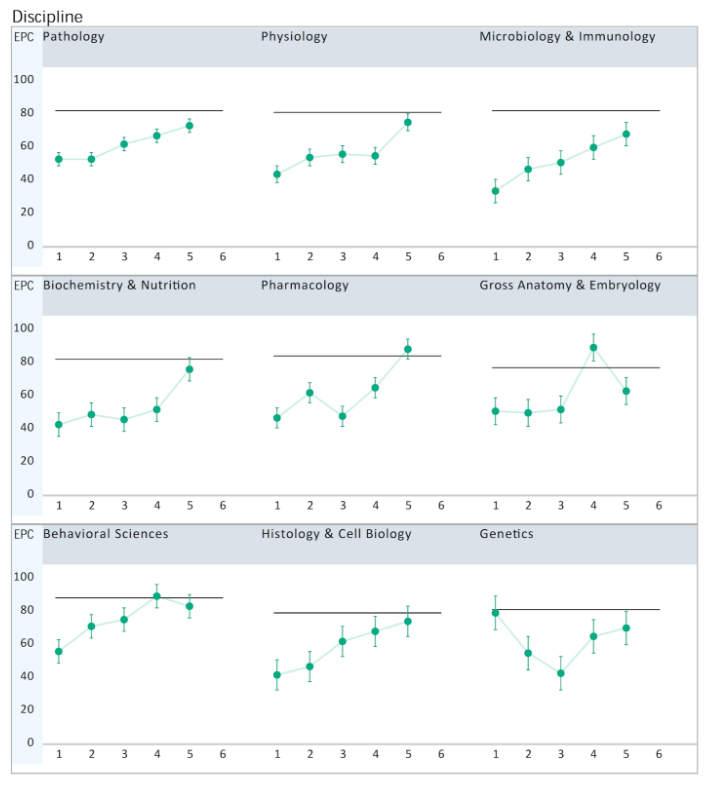
These figures will provide you with a visual representation of your progress. Ultimately, you should hope to see all subjects increase over time and approach the black line, which represents the “average estimated performance of the 2020 cohort of Step 1 first-takers”. The green circles “represent your EPC,” In contrast, the vertical lines represent the “precision of the scores.” Again, these data can help you determine which subjects require more study time than others. Remember to consider them in the context of how often they are seen on the test!
Overall, the NBME practice exams are an excellent accurate predictor of your performance on the USMLE Step 1. You should aim to spread them out across your study period, including one at the beginning to establish a baseline. This will help inform how you should customize your Step 1 study schedule to better target weak areas. The NBME practice exams also serve as an excellent predictor of when you are ready to take the exam.
Interpreting Your USMLE Step 2 Score Report
The practice tests from the NBME for USMLE Step 2 are also known as the Comprehensive Clinical Science Self-Assessment (CCSSA). Currently, there are 6 available CCSSAs after two new ones were released in May of 2022.
These tests consist of 200 multiple-choice questions (four blocks of 50 questions). You can take them in either standard-paced or self-paced mode. You will also receive a score report – you can find an example of this score report and an interactive copy of this score report. Given that you will receive a score on Step 2, the score report differs slightly from Step 1. Most importantly, you will receive a score on the same scale as USMLE Step 2. Let’s break the report down section by section:
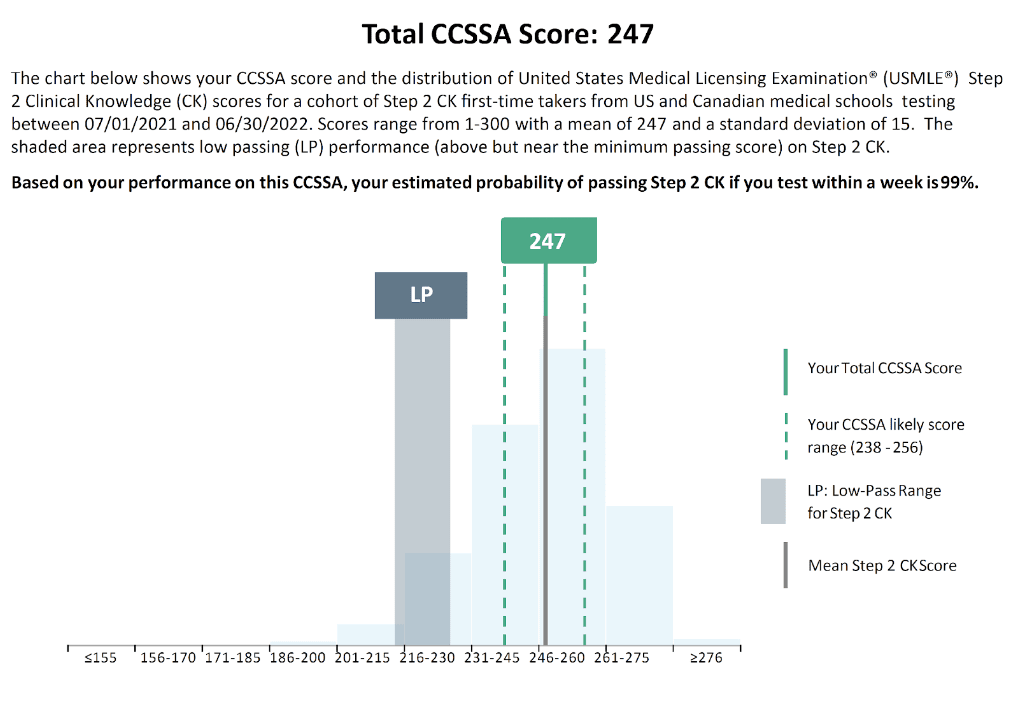
As mentioned above, rather than getting a TEPCS, you will get a Total CCSSA Score. According to USMLE’s website, the Total CCSSA score “represents an estimate of your USMLE Step 2 CK performance if you had taken both exams with the same level of knowledge”. Your estimated probability of passing is calculated similarly to those reported for Step 1 and is also valid within one week. Your CCSSA likely score is your USMLE Step 2 CK score ± 9 points. In the case of the example above, the student is likely to score within 238-256. The Low-Pass Range represents students who are passing but are near the minimum passing score, similar to Step 1.
Using Your NBME Score Report to Inform How You Study for Step 2 CK
After this figure, you will also have a breakdown of your performance by Physician Task, System, and Discipline. An example is shown below:
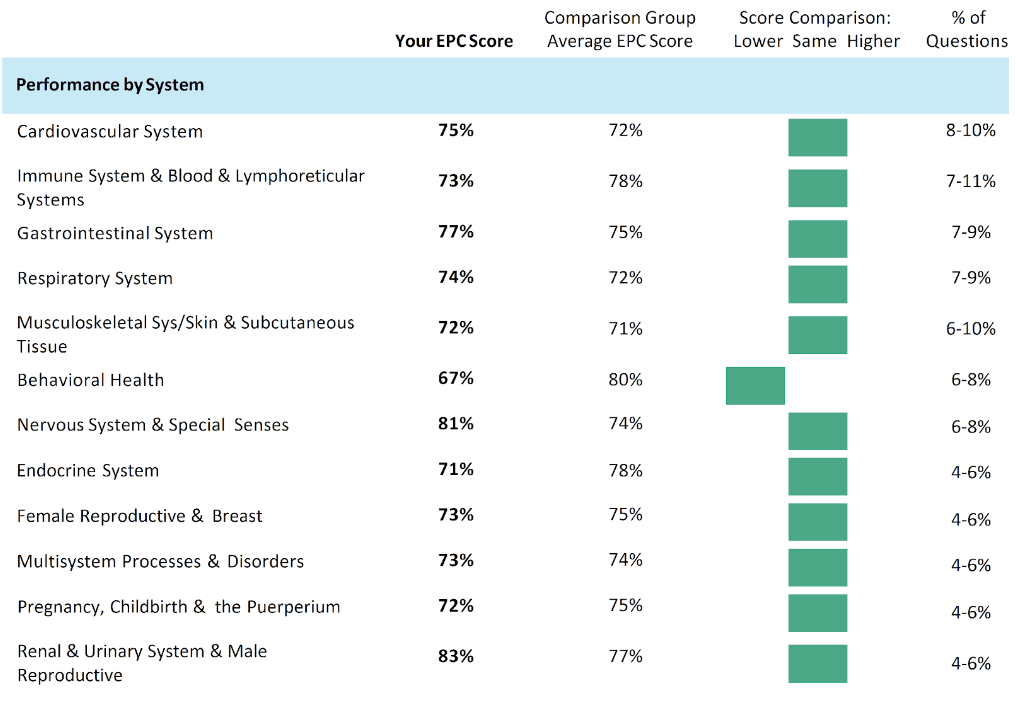
You should interpret this data similarly to how we recommend analyzing these data for Step 1 (see above). It should help you identify your weakness and help guide your studying by considering:
- Your EPC relative to the Average EPC Score
- The % of the test of this specific subject
Finally, similar to Step 1, you will be provided with visual representations of your performance over time if you have taken multiple CCSSAs:
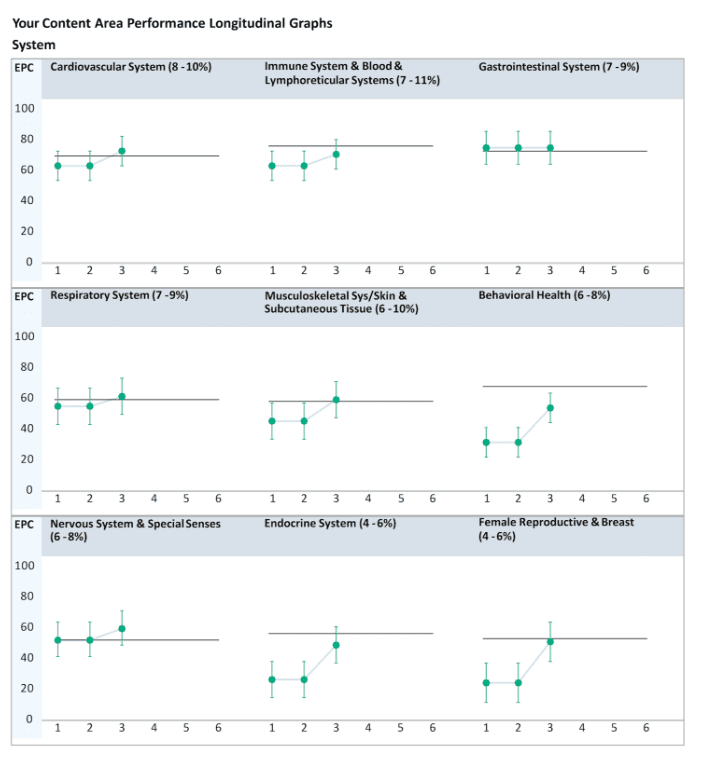
Like Step 1, you should aim to see all subjects increase over time and approach the black line. This represents the “average estimated performance of Step 2 CK first-takers”. The green circles “represent your EPC,” whereas the vertical lines represent the “precision of the scores.” The percentage of the test made up of that subject is shown in parentheses next to the subject title. Aim to spread your practice tests across your Step 2 study schedule to help you track your progress.
Final Recommendations
- For Step 1, we recommend taking the test once you score is around 95% likelihood of passing on at least TWO separate CBSSAs taken under test-taking conditions (standard-paced). This recommendation is conservative, and some students may be able to pass the test with a lower likelihood of passing. However, the amount of risk you can tolerate is an individual decision. We always recommend getting the highest chance of passing you can!
- The NBME practice tests are a very accurate predictor of Step 1 and Step 2 CK performance, but only within a week of taking them! The further removed you are from your last practice test, the less accurate the prediction will be.
- For Step 2, you should focus less on your likelihood of passing and obtaining the highest score possible. Your Step 2 score will play a significant role in your application for residency, and you should not just aim to pass; rather, you should aim to score as high as you can!
- Use the breakdown of your performance on these tests to guide your studying.
- We are human, and our performance will vary from day to day. Recognize that minor changes in your score between two tests may not reflect significant changes in your understanding of the content. We recommend taking multiple tests over time (weeks) to gauge your performance and improvement accurately.
If you need help creating a study plan or interpreting your test scores, a Step 1 or Step 2 tutor can be a great resource – reach out if you need help! Schedule your complimentary consultation with Elite Medical Prep today!
Featured Articles


